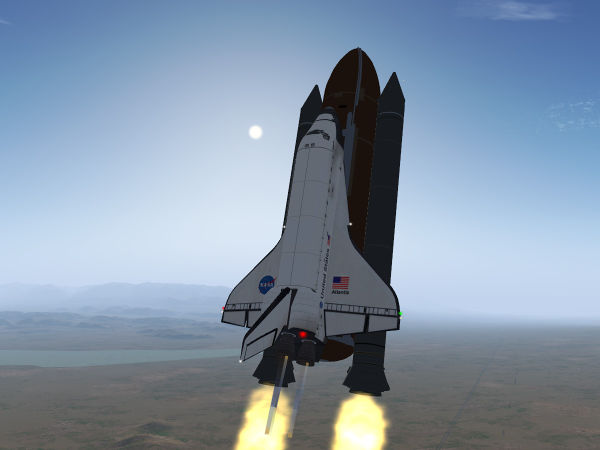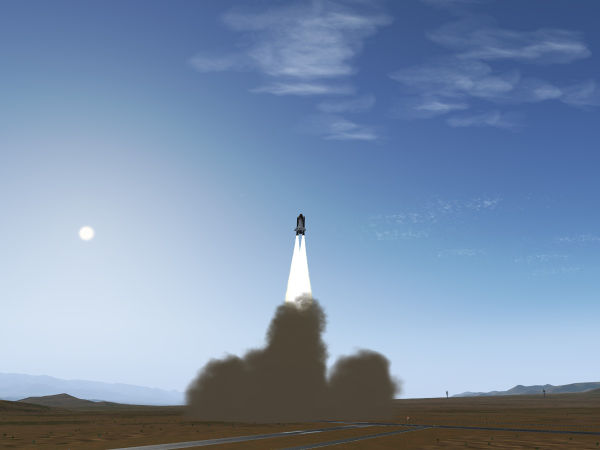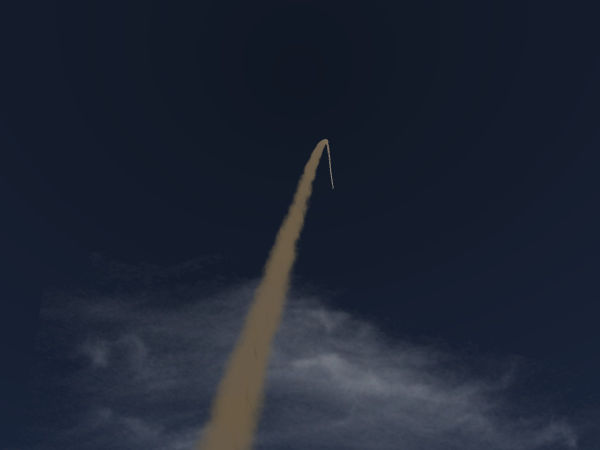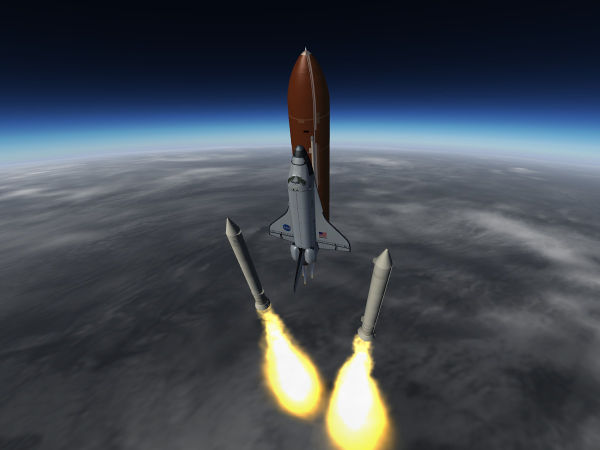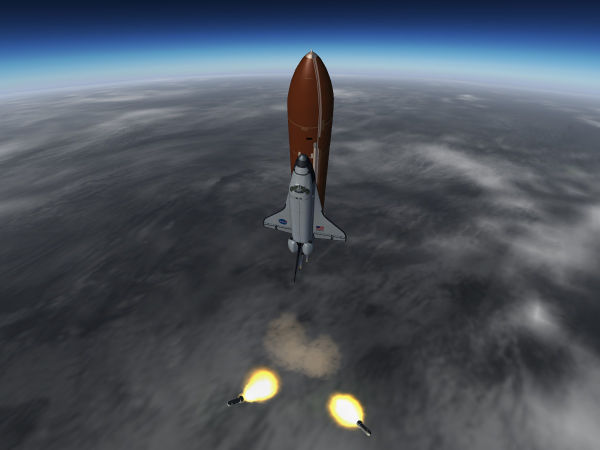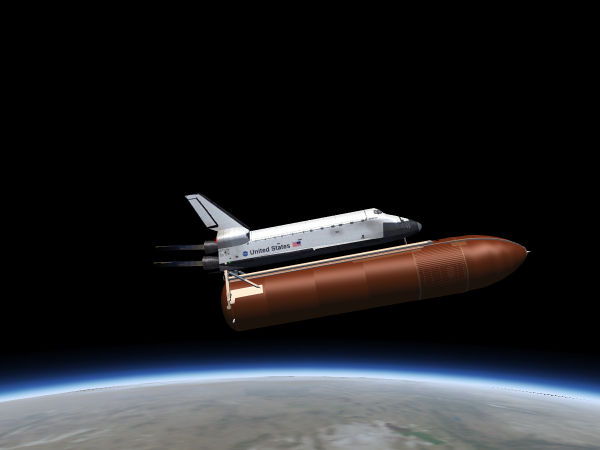Flying the Shuttle - Launch: Difference between revisions
(Created page with " {{Note|This article refers to the Space Shuttle in the FGAddon repository. }} This mission phase can directly be started using <b>--aircraft=SpaceShuttle-launch</b> on the...") |
No edit summary |
||
| Line 17: | Line 17: | ||
* accelerate to orbital speed outside the atmosphere | * accelerate to orbital speed outside the atmosphere | ||
[[File:Shuttle FG03.jpg|600px|Space Shuttle Launch]] | |||
| Line 32: | Line 32: | ||
[[File:Shuttle FG02.jpg|600px|Space Shuttle Launch]] | [[File:Shuttle FG02.jpg|600px|Space Shuttle Launch]] | ||
Upon ascent, the shuttle is controlled by thrust vectoring of both the SRBs and the SSME. About ten seconds after liftoff while the dynamical pressure is still small, roll the shuttle to the desired launch course, then pull slightly down to a pitch of 80-85 degrees of inverted flight (the journey into orbit is flown with the head hanging down). You should now verify that you are approximately (within 10-20 degrees) on your launch course. Don't worry about details, they can be fixed later. | |||
At about 35 seconds into the flight, dynamical pressure (qbar) will rise rapidly as the stack goes supersonic. This is a dangerous phase of the flight. The stack is very top-heavy (as the heavy oxygen is stored in the tip of the ET and the light hydrogen in the bottom), so once it starts toppling, it won't come back. In addition, aerodynamical forces are very strong. In fact the very reason we do this phase in inverted flight is to reduce the wing loading. At the callout, reduce throttle of the main engines to 65% to minimize the pressure spike. | |||
If you ascent is too flat in this phase, maximum qbar will be violated, or more likely, you'll lose control of the stack beyond the point the thrust vectoring can recover. | |||
About 20 seconds later, max. qbar is over and the stack becomes much more controllable. Reduce pitch to about 60 degrees (still inverted) and keep rising. | |||
[[File:Shuttle launch01.jpg|600px|Launch track of the Space Shuttle]] | [[File:Shuttle launch01.jpg|600px|Launch track of the Space Shuttle]] | ||
Seen from the ground, the smoke trail of the launch shows clearly the point at which the shuttle departs from vertical ascent and reduces pitch. | |||
[[File:Shuttle SRBsep03.jpg|600px|SRB separation]][[File:Shuttle SRBsep04.jpg|600px|SRB separation]] | |||
[[File:Shuttle FG5.jpg|600px|Final stage in the flight to orbit]] | [[File:Shuttle FG5.jpg|600px|Final stage in the flight to orbit]] | ||
== Further reading == | == Further reading == | ||
Revision as of 15:14, 19 April 2015
| Note This article refers to the Space Shuttle in the FGAddon repository. |
This mission phase can directly be started using --aircraft=SpaceShuttle-launch on the command line.
What are we trying to do?
The launch phase of the Shuttle lasts from ignition of the main engines till the shuttle reaches orbit. This is a surprisingly short time, all in all just about eight minutes. During this time, an enormous amount of propellant is spent accelerating the orbiter to Mach 26 at an altitude of 150 km. The complete launch stack consists of the orbiter, mounted on the external tank (ET) which supplies propellant for the Space Shuttle Main Engines (SSMEs), assisted by two solid rocket boosters (SRBs).
The first two minutes of the flight pass through the atmosphere, during this time the SRBs provide most of the thrust. The SRBs can not be throttled, once on, they burn till they are spent. At an altitude of about 150.000 ft the SRBs are disconnected and the shuttle accelerates only using the main engines fed from the ET which is disconnected just before reaching orbit.
The tasks are hence
- bring the orbiter safely through the atmosphere
- steer towards a launch course corresponding to an orbit with the desired inclination
- accelerate to orbital speed outside the atmosphere
Some theory
How it feels in FG
The launch dynamics in FG is, if we neglect the noise and the shaking of the real thing (which is described as 'driving down a rough gravel road without any suspension, a shaking so hard the eyes cannot properly focus' as long as the SRBs are burning) probably fairly realistic.
As soon as the throttle is moved to 65%, the main engines ignite. This is the starting signal for SRB ignition, the SRBs will follow three seconds later, and once they burn, there is no going back. The SRBs can not be throttled and will burn till exhausted, and they have enough thrust to lift the stack even if the main engine is switched off.
Upon ascent, the shuttle is controlled by thrust vectoring of both the SRBs and the SSME. About ten seconds after liftoff while the dynamical pressure is still small, roll the shuttle to the desired launch course, then pull slightly down to a pitch of 80-85 degrees of inverted flight (the journey into orbit is flown with the head hanging down). You should now verify that you are approximately (within 10-20 degrees) on your launch course. Don't worry about details, they can be fixed later.
At about 35 seconds into the flight, dynamical pressure (qbar) will rise rapidly as the stack goes supersonic. This is a dangerous phase of the flight. The stack is very top-heavy (as the heavy oxygen is stored in the tip of the ET and the light hydrogen in the bottom), so once it starts toppling, it won't come back. In addition, aerodynamical forces are very strong. In fact the very reason we do this phase in inverted flight is to reduce the wing loading. At the callout, reduce throttle of the main engines to 65% to minimize the pressure spike.
If you ascent is too flat in this phase, maximum qbar will be violated, or more likely, you'll lose control of the stack beyond the point the thrust vectoring can recover.
About 20 seconds later, max. qbar is over and the stack becomes much more controllable. Reduce pitch to about 60 degrees (still inverted) and keep rising.
Seen from the ground, the smoke trail of the launch shows clearly the point at which the shuttle departs from vertical ascent and reduces pitch.
